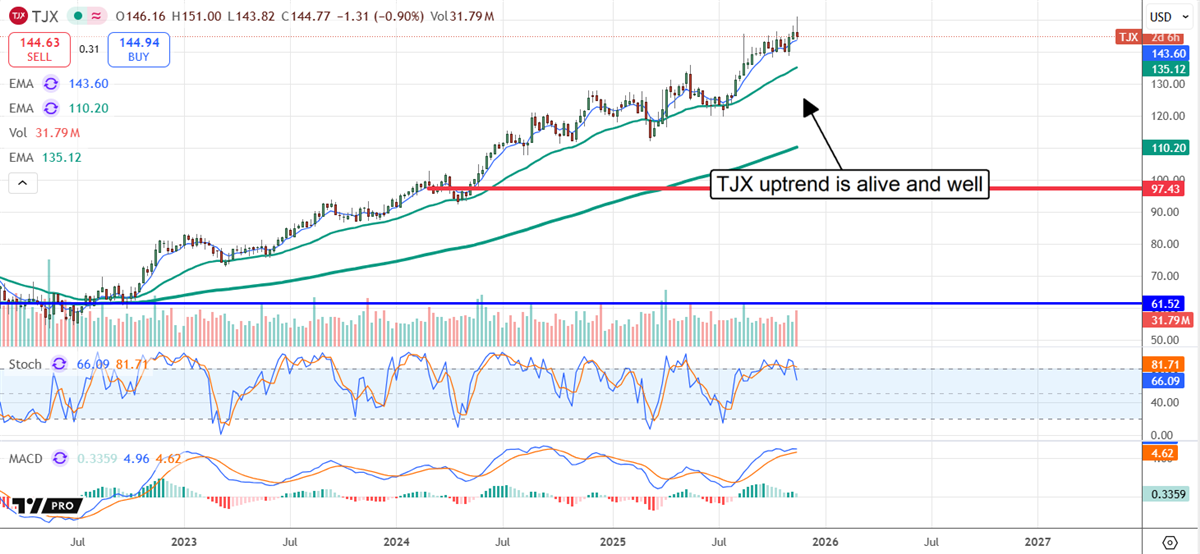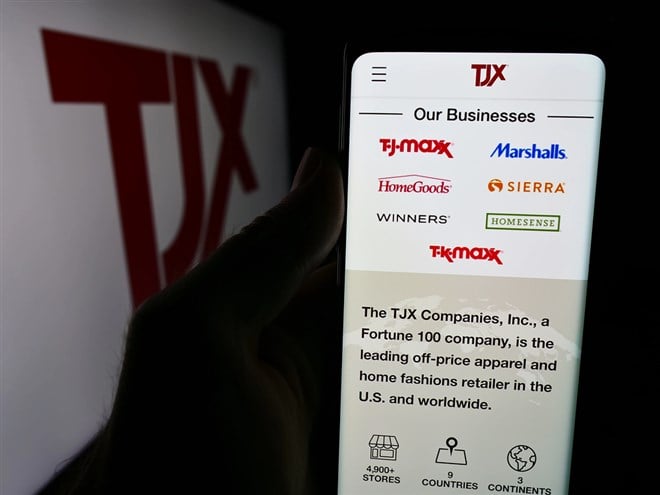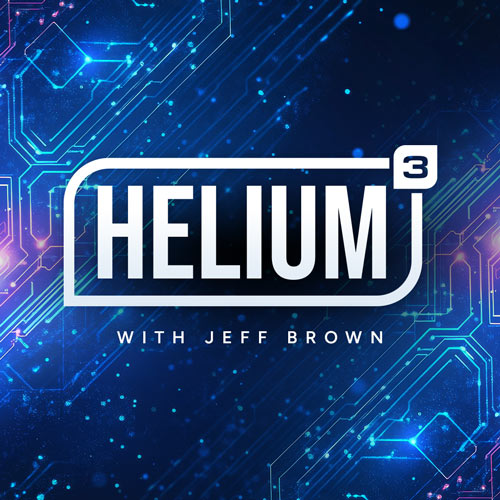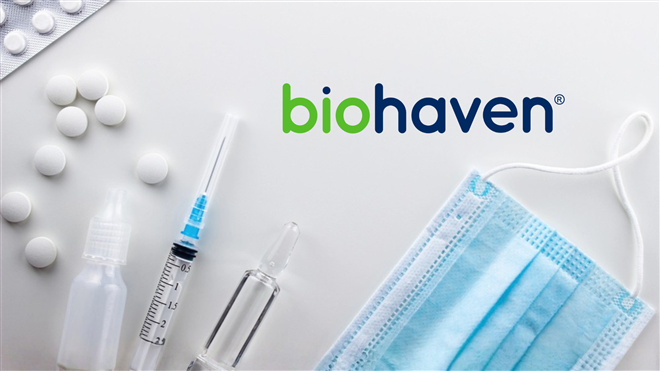Ticker Reports for November 20th
The Off-Price Retail King? Why TJX Looks Ready to Break Out
The macroeconomic and retail conditions are ideal for The TJX Companies' (NYSE: TJX) business, as reflected in its results and stock price.
The macroeconomic headwinds that have shifted consumer habits and profoundly affected results for major retailers have created a favorable buying environment for off-price retailers like The TJX Companies, enabling it to offer attractive values to still-resilient consumers.
The takeaway is that industry-leading growth in Q3 is compounded by outperformance and improved Q4 guidance, which is likely to be cautious. The uptrend in TJX shares is expected to continue.

TJX Companies Outperforms and Raises Guidance for the Year
The TJX Companies had a fantastic quarter, reporting revenue of $15.12 billion, up 7.0% year-over-year (YOY) and 175 basis points better than consensus. Strength was driven by a 5% systemwide comp, strength across all divisions, and a 1.1% increase in store count.
TJX Canada grew the fastest, up by 8% YOY, followed by a 6% increase in the core Marmaxx divisions, a 5% increase in Home Goods, and a 3% gain internationally. All segments posted stronger net growth, contributing to margin strength as well.
Margin news is also fantastic. The selling environment and revenue leverage led to a 100 basis point improvement in gross margin, compounded by operating improvements, resulting in leveraged earnings gains. The GAAP EPS increased by 12% including the impact of share repurchases, which reduced the count by an average of 1.3% for the quarter.
TJX Companies provided guidance for Q4 that was somewhat lower than expected. Nonetheless, the shortfall is minor compared to MarketBeat’s consensus and does not diminish the strong performance seen in the first year-to-date period.
The net result is that full-year guidance was increased, now expecting comp store growth of 4% and earnings of $4.63 at the low end, more than a nickel above the consensus estimates. Based on the trends, it is likely that the guidance will be cautious, and outperformance will be posted in January when Q4 results are released.
Capital Returns Drive TJX Companies Stock Price Higher
Capital returns are among the drivers of the TJX stock price. The company pays dividends and buys back shares, reducing its share count aggressively each year. The dividend is average, compared to the S&P 500, but it is safe, and the distribution is growing.
The payout ratio is low, below 40%, so annual increases are likely to continue for this Dividend Aristocrat. As it stands, not counting the COVID-19 pause, the company has increased its distribution annually for nearly 30 years and can sustain a double-digit compound annual growth rate for the foreseeable future.
TJX Companies' balance sheet provides no red flags for investors, only incentives for ownership. The Q3 highlights include increased current and total assets, driven by cash and inventory increases, offset by smaller gains in liabilities and a reduction in debt. The net result is a nearly 15% increase in shareholder equity, accompanied by persistently low leverage. The company is net cash, with long-term debt running at approximately 0.2x equity.
Analysts Trends Drive TJX Stock to New Highs
The analysts' trends are robust and in alignment with the fundamental and technical outlook. They include increased coverage, firming sentiment, a Buy rating from 25 analysts, and an upward trend in the price target.
The consensus assumes the stock is fairly valued following the Q3 release, but the trend points to the high end of the range, near $170, and another 17% upside from mid-November levels.
Everyone's wrong about this crypto right now
Everyone's wrong about this crypto right now
Intel Could Be the Biggest Winner of TSMC's AI Bottleneck
The artificial intelligence (AI) revolution has sparked such intense demand for advanced semiconductors that it is creating a global manufacturing bottleneck. However, this is not a story of failure, but rather one of overwhelming success. The industry’s leading manufacturer, Taiwan Semiconductor Manufacturing Co. (NYSE: TSM) (TSMC), is operating at the peak of its powers. Yet, the market is growing faster than any single company can scale. This has created a high-quality problem for the entire technology sector.
Data from TSMC’s recent earnings reports highlight the pressure. High-Performance Computing (HPC), the segment driven by AI, now accounts for 57% of its revenue. Its most advanced and complex manufacturing processes (nodes of 7-nanometer or smaller) account for 74% of its total sales. This concentration of demand forces the world’s most prominent chip designers to confront the risks of a single-source supply chain. For companies whose multi-billion-dollar product launches depend on access to these chips, any delay or disruption can be catastrophic. This has made supply chain diversification a top priority, creating the most significant opening for a competitor in over a decade, with Intel (NASDAQ: INTC) emerging as the primary candidate to fill a crucial industry need.
Intel's De-Risked Answer to the Supply Crunch
In response to this supply crunch, Intel is positioning its foundry business as a viable and vital solution. For years, investors have watched the company’s ambitious IDM 2.0 strategy (a plan to build chips for external customers) with a healthy dose of skepticism. However, recent developments suggest the strategy is moving from an aspiration to a tangible, financially de-risked reality.
A key concern for investors has been the enormous capital required for Intel’s turnaround. This risk has been substantially mitigated by a recent influx of capital and strategic support totaling nearly $20 billion. This includes funding from the U.S. CHIPS Act, a $2.0 billion investment from SoftBank, and a crucial $5.0 billion investment from NVIDIA (NASDAQ: NVDA). This financial fortification provides Intel with the stability to execute its long-term manufacturing expansion, a vital factor given that its foundry division reported a $2.3 billion operating loss in its third-quarter 2025 earnings release alone.
This strategy is not just financial; it is grounded in concrete technological progress and a key geopolitical advantage. Intel’s Fab 52 in Arizona, a facility dedicated to its next-generation Intel 18A process, is now fully operational, offering a U.S.-based alternative to Asia-centric supply chains. The company has already unveiled its own flagship products built on this node, such as Panther Lake CPUs, effectively demonstrating the technology's viability at scale through its own product lines. For potential customers, Intel also offers its advanced packaging technologies (EMIB, Foveros) as a potential gateway, allowing them to engage with Intel’s manufacturing ecosystem before committing to a full wafer contract.
Why NVIDIA's Bet on Intel Changes the Game
Among the recent strategic moves, the collaboration with NVIDIA stands out as a pivotal event for Intel. More than just a financial injection, the partnership is a powerful technical and strategic endorsement from the undisputed leader in artificial intelligence. This development serves as a significant market signal that helps validate Intel’s long-term technology roadmap.
The collaboration centers on integrating Intel’s x86 CPUs with NVIDIA’s accelerated computing platforms using NVIDIA’s proprietary NVLink interconnect technology. In simple terms, this creates a high-speed data bridge between the two companies' core technologies, enabling them to work together more efficiently in AI data centers. For Intel, this move is critical. It reinforces the relevance of its CPUs in the AI era and provides a direct pathway into NVIDIA’s dominant hardware and software ecosystem.
For investors, this partnership is a powerful catalyst that directly counters the narrative that Intel is being left behind in the AI race. It signals to other potential foundry customers that the industry’s most important AI player sees Intel as a key long-term collaborator. This endorsement mitigates perceived risk and could make it easier for other fabless companies to commit to Intel’s manufacturing services, knowing that a foundational level of ecosystem support is in place.
From Turnaround Story to Supply Chain Solution
For investors, the evolving landscape presents a compelling opportunity. While the market has focused on Intel’s internal challenges, a powerful external catalyst, a structural shortage of leading-edge manufacturing capacity, is reshaping the competitive environment in its favor. The contrast in market valuation is stark: Intel’s market capitalization of approximately $168 billion is just a fraction of TSMC’s $1.46 trillion. With a price-to-sales ratio (P/S) of around 3, Intel trades at a significant discount to TSMC's ratio of over 10, highlighting the potential upside for Intel’s stock price if its foundry business gains traction.
Securing a single, high-volume customer for its 18A node would be a transformative event, providing the ultimate validation of its IDM 2.0 strategy and creating a clear path to profitability for the foundry division. The prevailing Reduce rating from the analyst consensus seems to reflect skepticism rooted in past performance. This creates a potential opportunity for investors who recognize the forward-looking catalysts that may not yet be fully priced into the stock.
As the industry navigates this period of high demand, investors should monitor a few key signposts that will indicate Intel’s strategy is succeeding:
- A public announcement of a major, high-volume foundry customer for the Intel 18A process.
- Positive updates on 18A manufacturing yields and performance metrics in upcoming earnings calls.
- Further strategic partnerships that leverage Intel's growing U.S.-based manufacturing footprint.
TSMC’s dominance is not in immediate jeopardy. However, the ground is clearly shifting. The industry needs more capacity, and Intel is emerging as a well-funded and strategically positioned solution.
Forget AI, This Will Be the Next Big Tech Breakthrough
Forget AI, This Will Be the Next Big Tech Breakthrough
Biohaven Insiders Bet $33 Million on a Turnaround
When corporate executives make multi-million-dollar personal investments in the company they lead, it is one of the most potent signals an investor can receive. At Biohaven (NYSE: BHVN), that signal has just been sent loud and clear.
Following a period of significant stock price pressure, the company’s top leadership, including its CEO and key directors, has collectively purchased more than $33 million worth of their own stock.
These are not routine, pre-planned acquisitions; they are substantial, open-market buys made in a single stroke. Such a decisive financial commitment suggests a deep-seated belief from those with the most intimate knowledge of the company’s operations and prospects that Biohaven’s stock price is fundamentally undervalued. It points to a conviction that the market is focusing on past setbacks while overlooking a pipeline of catalysts on the horizon.
Turning Crisis into Conviction
To understand the significance of Biohaven’s insider purchases, it is crucial to look at the events that preceded them.
The stock has fallen by more than 74% year-to-date, trading well below its 52-week high of $47.75. The primary catalyst for this decline was a major regulatory setback in early November 2025, when Biohaven received a Complete Response Letter (CRL) from the U.S. Food and Drug Administration (FDA) for its drug candidate troriluzole. A CRL indicates that the agency cannot approve the drug application in its current form, effectively pausing its path to market.
The market’s reaction was swift and severe, pushing the stock to a 52-week low of $7.48. However, Biohaven’s management responded in kind, executing a two-part plan that reshaped the company’s strategic and financial footing.
First, the company announced a major strategic reprioritization. It narrowed its focus to its three most promising late-stage clinical programs, a move designed to reduce annual R&D spending by an estimated 60%. This demonstrated a disciplined approach to capital allocation, ensuring resources were directed toward assets with the highest potential to create value.
Second, Biohaven secured its financial runway by closing an upsized public offering that raised approximately $200 million. This capital raise not only shored up Biohaven’s balance sheet but also provided the very vehicle for insiders to make their move.
They didn't just ask the market for more capital; they participated in the offering themselves, buying shares at $7.50, a price point near the stock's multi-year lows. This contrarian action suggests they believe the market’s punishment was excessive, creating an attractive entry and accumulation point.
The Catalysts Fueling the $33 Million Bet
The confidence demonstrated by the $33 million insider investment is not based on hope; it is rooted in the potential of a streamlined and de-risked clinical pipeline. Management’s focus is now on three core platforms, each with significant upcoming milestones.
- The Neuroscience Pillar (Opakalim): Considered Biohaven’s lead asset, Opakalim is being developed for major neurological and psychiatric conditions. Its potential is being tested in large, critical markets. Two pivotal Phase 3 trials for focal epilepsy are underway, with the first data expected in the first half of 2026. A more immediate catalyst is the top-line data from a Phase 2 study in Major Depressive Disorder (MDD), expected in the fourth quarter of 2025. Positive results from either program could serve as a major value inflection point.
- The Metabolic Pivot (Taldefgrobep Alfa): Biohaven has strategically shifted the focus of this asset toward the massive obesity market. A Phase 2 trial is scheduled to begin in the fourth quarter of 2025. The drug’s compelling mechanism aims to reduce fat while preserving lean muscle mass. This key differentiator could address a significant unmet need in weight management and potentially position it as a complementary therapy to existing treatments.
- The Next-Generation Platform (Protein Degraders): This platform represents Biohaven's high-science, high-reward opportunity in immunology. Using its novel MoDE and TRAP technology, the company is developing therapies to selectively remove disease-causing proteins from the body. Lead programs include BHV-1300 for autoimmune conditions like Graves' disease and BHV-1400 for IgA nephropathy, a severe kidney disease. Success here could validate a platform capable of producing multiple transformative medicines.
The Leadership Team Is All In
The more than $33 million investment from Biohaven’s leadership is a calculated bet on the company's future, founded on a clear strategic plan and a pipeline with multiple near-term catalysts. The move powerfully aligns management's financial interests with shareholders', sending a clear message that they are confident in their ability to execute on their newly focused goals.
While analyst price targets have been trimmed to reflect recent setbacks, the consensus rating remains a Moderate Buy, with an average price target of $31.21.
This suggests that Wall Street, like the company's insiders, sees significant upside—more than 200%—from current levels.
For investors, this skin in the game provides a compelling counter-narrative to the recent market pessimism. While clinical-stage biotechnology investing always involves a degree of uncertainty, the decision by insiders to commit such a substantial amount of personal capital suggests they believe Biohaven is at an inflection point, with its current valuation failing to reflect the significant potential of its core clinical assets.
This memecoin could explode soon (see it here)
This memecoin could explode soon (see it here)






